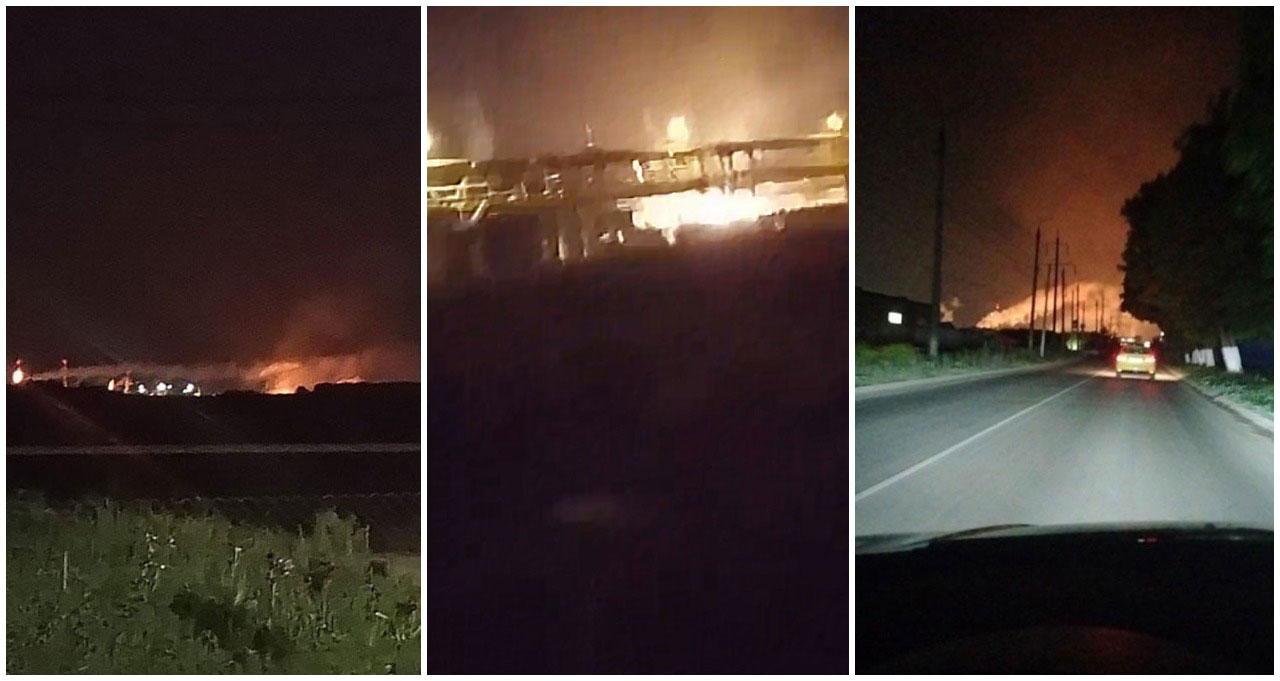Ukrainian drones struck the Azot chemical plant in Tula Oblast linked to explosives production, marking the second attack on the facility in two weeks, overnight on 8 June. Yesterday, resumed Ukrainian attacks on oil processing facilities continued with a strike on a bitumen production site near a major oil refinery in Kstovo, Nizhny Novgorod Oblast.
Tula Oblast’s Azot chemical plant hit again
The Azot facility in Novomoskovsk, Tula Oblast, has increasingly become a target in Ukraine’s long-range drone operations due to its role in Russia’s defense production.
On 8 June, Russian sources reported that drones targeted the Azot around 400 kilometers from Ukraine. The attack caused explosions and a fire at the plant, according to Russian pro-government Telegram channels, including VChK-OGPU, which stated shortly after midnight that that “an UAV hit the NK Azot pipe in Novomoskovsk” shortly past midnight.
Russian news Telegram channels Astra noticed that eyewitnesses reported hearing five to eight loud explosions. Citing local Telegram channels, Astra said the drones hit the Azot chemical plant, which produces substances used in the manufacture of explosives for artillery shells.
About 2:30 a.m., Tula Oblast governor Dmitry Milyaev confirmed the strike and the resulting fire, stating that it broke out after drone debris hit the site. In his official Telegram post, he added,
“The fire has been extinguished. No exceedance of permissible pollutant levels has been recorded. […] Two people were injured, but their lives are not at risk. Emergency services are working at the site.”
Ukrainian Telegram channel Exilenova+ suggested, based on available footage, that the strike on the Azot plant in Novomoskovsk likely hit the main pipeline access area, not the processing units themselves. In video reportedly filmed on-site, a worker says: “Basically, it hit a pipe — a gas one, a propane line.” The channel noted that further OSINT is needed for confirmation.
Second attack on Azot in weeks
This is the second drone strike on the plant in recent weeks. The previous attack occurred on 24 May, when drones hit a low-pressure gas pipeline in workshop No. 4, damaging two 750-ton nitric acid tanks. One tank leaked onto the ground, prompting a full shutdown of the facility. Governor Milyaev then reported damage to an acid storage unit during emergency response operations.
Fuel facility near Kstovo also struck
In the afternoon of 7 June, Ukrainian drones reportedly targeted another industrial site – JSC Bitumnoye Proizvodstvo bitumen plant – near the Lukoil refinery in Kstovo, Nizhny Novgorod Oblast, about 800 km from Ukraine. Local Telegram channels shared video of the incident.
It remains unclear whether the bitumen plant or the refinery was the intended target.
The Russian Ministry of Emergency Situations confirmed a major fire broke out, stating:
“According to updated information, bitumen production units with a total volume of 200 cubic meters are burning. A firefighting train has departed from the Zelecino station. More than 70 specialists and 26 pieces of equipment are involved in extinguishing the blaze.”
Resumed attacks on fuel facilities
Ukraine resumed its attacks against Russian fuel storage and processing facilities on 6 June after a few-month pause, by targeting the Rosrezerv’s Kristall fuel depot in Engels, Saratov Oblast, where aviation fuel for Russia’s strategic bombers is stored. Before that, the most recent attack of this kind occurred on 18 March, when Ukrainian drones targeted the Kavkaz oil transshipment terminal in Russia’s Krasnodar Krai.
After months, Ukraine resumes strikes on Russian fuel depots, targets airfields and military factories (video)
However, Militarnyi suggests that the Kristall strike “could have been part of the series of attacks on Russia’s long-range capabilities,” given it stores fuel for strategic aviation. However, the 7 June strike on the Kstovo plant removes ambiguity, as it “provides grounds to assert that Ukraine has resumed attacks on Russia’s oil industry,” the outlet wrote.
Read also
-
Trump says Ukraine’s drone strike on Russian military planes justifies bombardment of civilians
-
Mi-8 military helicopter blown up, Mi-35 wrecked as Ukraine hits Russia’s Bryansk airport, media says
-
After months, Ukraine resumes strikes on Russian fuel depots, targets airfields and military factories (video)




